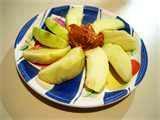 Yes, we all know that much of the junk food out there usually costs less than healthy snacks.
Yes, we all know that much of the junk food out there usually costs less than healthy snacks.
We also know that regularly consuming junk food can pack on the pounds.
Well here is some good news about snacks.
From 2006 to 2008, researchers from Harvard School of Public Health evaluated the snacks offered to kids at 32 YMCAs in four cities in the U.S. Pacific Northwest, South, Midwest and East. Researchers found that health snacks and/or snack combinations don’t have to cost more than junk food.
The YMCA sites participated in a program called the YMCA/Harvard Afterschool Food and Fitness Project, designed to improve the diets and boost physical activity among kids aged 5 to 12 attending the Ys’ after-school programs.
The project set out standards for snacks served at YMCAs, including: serving water instead of sugar-sweetened beverages, offering whole grains and a fruit or vegetable with each snack and avoiding trans fats.
The average cost per snack was 57 cents, with prices ranging from 47 cents in the Midwest and Northeast to 78 cents in the Pacific Northwest. As expected, snacks that met the healthy eating standards cost 50 percent more than those that didn’t.
Yet, some YMCAs found ways of mixing and matching combinations that both met the healthy eating standards and kept costs at or even below what it would cost to serve less healthy snacks.
Some Ys served water instead of fruit juice, which significantly reduced the price of a snack. Instead of the fruit juice, Ys could serve water and a banana or apple slices and water, and the snack had the same calorie count at a lower cost. The whole fruit has the added nutritional benefits of fiber and helping kids feel fuller, longer than juice.
Another example was serving water and cheese, which is less expensive than serving chocolate milk, and the cheese contains less sugar.
Other areas where Ys could make improvements without adding to cost were substituting whole grains, in foods such as Triscuits, Wheat Thins and Cheerios, for refined grains such as graham crackers and Saltines.
Snacks that include canned or frozen vegetables are on the pricy side, but snacks including fresh vegetables, such as carrots and celery, are not.
The study is in the February issue of the journal Preventing Chronic Disease.
Joy Dubost, a registered dietitian and spokeswoman for the Academy of Nutrition and Dietetics, called the study “well-conducted.” However, the five criteria used to determine what qualifies as a healthy snack option aren’t as comprehensive as she would like.
She cited tortilla chips counting as a whole grain and therefore meeting the criteria for a healthy snack option, but they’re also full of saturated fat, which may contribute to heart disease over the long term.
“Applesauce counts as a fruit, but it would be better if the guidelines specified that the after-school programs choose applesauce without added sugar. In addition to addressing saturated fats and added sugars, the healthiest after-school snack would take into account calories and sodium, which many American children get too much of as well,” Dubost said.
For more on choosing healthy snacks for children, visit Food and Fun After School.
(SOURCES: Rebecca Mozaffarian, M.S., M.P.H., project manager, YMCA/Harvard Afterschool Food and Fitness Project; Joy Dubost, R.D., registered dietitian and spokeswoman, Academy of Nutrition and Dietetics; February 2012, Preventing Chronic Disease)

